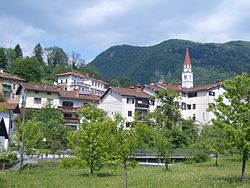Most na Soči
|
Most na Soči Sveta Lucija ob Soči (until 1955) |
|
|---|---|
 |
|
| Location in Slovenia | |
| Coordinates: 46°9′8.24″N 13°44′39.6″E / 46.1522889°N 13.744333°ECoordinates: 46°9′8.24″N 13°44′39.6″E / 46.1522889°N 13.744333°E | |
| Country |
|
| Traditional region | Slovenian Littoral |
| Statistical region | Gorizia |
| Municipality | Tolmin |
| Area | |
| • Total | 1.57 km2 (0.61 sq mi) |
| Elevation | 179 m (587 ft) |
| Population (2002) | |
| • Total | 236 |
Most na Soči (pronounced [ˈmoːst na ˈsoːtʃi]; formerly Sveta Lucija or Sveta Lucija na Mostu,German: Sankt Luzia) is a town in the Municipality of Tolmin in the Littoral region of Slovenia. It is located on a rocky crest above the confluence of Soča and Idrijca rivers. In the past these two riverbeds, deeply carved into the rocky slopes, provided the settlement with excellent protection from intruders. Due to the nearby Doblar hydro plant, the basins of the river were entirely inundated and below the settlement a vast reservoir was formed, which now attracts both fishermen and visitors, who can stroll along some well-kept panoramic paths.
Most na Soči was first attested as In Ponte Sancti Mauri (literally, 'at Saint Maurus' bridge') in reference to the local church. In the 17th century, the name ad Pontem 'at the bridge' was recorded, and a church built between 1584 and 1612 was the source of the name Sveta Lucija (na Mostu) 'Saint Lucy (on the bridge)'. Under Italian administration, the settlement was known as Santa Lucia (di Tolmino) 'Saint Lucy (of Tolmin)', and after the Second World War the Slovene name Sveta Lucija ob Soči 'Saint Lucy on the Soča River' was established. Other historical names include German St. Luzia and Maurus Brucke. The name of the settlement was changed from Sveta Lucija ob Soči to Most na Soči (literally, 'bridge on the Soča River') in 1955. The name was changed on the basis of the 1948 Law on Names of Settlements and Designations of Squares, Streets, and Buildings as part of efforts by Slovenia's postwar communist government to remove religious elements from toponyms.
Exceptional archaeological finds – more than 7,000 grave sites discovered so far – rank this location among one of the most important prehistoric settlements in Europe. Rich finds date back in the period from the late Bronze Age to Roman period. Most of them originate from an Iron Age community which was named the Sveta Lucija Culture. The finds are on display at many museums, i.e. in Vienna, Trieste, and Tolmin. Archeologists from the Tolmin Museum are still discovering stunning finds.
...
Wikipedia

